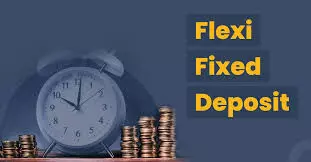Flexible Returns: Exploring Flexi Fixed Deposit Interest Rates

Fixed Deposits (FDs) have been a dependable savings option for many Indian households for generations. They offer a reliable method for preserving your capital and generating a predictable return on your investment. However, in today's dynamic financial landscape, where financial needs can change unexpectedly, the inherent rigidity of traditional FDs can be a drawback. Here’s where Flexi Fixed Deposit (FD) come in. These are financial instruments designed to bridge the gap between the security of FDs and the accessibility of readily available funds.
Beyond the Basics: Unpacking Flexi FDs
Unlike their traditional counterparts, Flexi FDs offer a degree of flexibility that caters to a wider range of financial needs. Here's what sets them apart:
Partial Withdrawals: A key advantage of Flexi FDs is the ability to make partial withdrawals during the tenor. This allows you to access a portion of your principal amount for unexpected expenses, unlike a traditional FD where your entire investment is locked in until maturity. This flexibility provides a safety net for unforeseen circumstances while still allowing your remaining principal to earn interest.
Overdraft Facility: Some issuers may offer an overdraft facility linked to your Flexi FD. This allows you to borrow a predetermined amount against your deposited funds, often at a rate higher than the FD interest rate. This feature can be helpful for short-term cash flow needs, but it's crucial to be mindful of the higher interest rate associated with the overdraft to avoid accumulating significant debt.
Interest Calculation: Interest on a Flexi fixed deposit is typically calculated on the remaining principal amount after each withdrawal. This means the overall interest earned might be slightly lower compared to a traditional FD with the entire principal invested throughout the tenor. While the interest earned might be slightly lower, the flexibility of accessing funds can be valuable for some investors.
The Appeal of Flexi FD Interest Rates
Flexi FDs generally offer competitive interest rates compared to traditional FDs. Issuers might even incentivise Flexi FDs with slightly higher rates than their regular counterparts to attract customers seeking both security and flexibility. However, it's important to remember that interest rates are not fixed and can fluctuate depending on several factors, including:
Market Conditions: Interest rates on FDs, both traditional and Flexi, are influenced by the overall economic landscape. When interest rates rise in the economy, banks and NBFCs typically offer higher FD rates to attract deposits. Conversely, falling interest rates might lead to lower FD rates.
Deposit Amount: Some issuers offer tiered interest rates on FDs, with higher rates offered for larger deposits. This can be an advantage if you're investing a significant sum in a Flexi FD.
Tenor: Generally, longer tenors on FDs command higher interest rates. This applies to both traditional and Flexi FDs.
To get the best deal, it's crucial to compare Flexi FD interest rates offered by different issuers. Utilising an FD interest calculator can be a valuable tool in this process. By factoring in the tenor, principal amount, and potential for partial withdrawals, these calculators can help you estimate the potential returns you can expect from different Flexi FD options.
Key Considerations for Flexi FDs
While Flexi FDs seem attractive due to their flexibility and potentially higher interest rates, there are some key considerations to keep in mind before investing:
Maintaining Discipline: The ability to make withdrawals can be a double-edged sword. Maintaining financial discipline is crucial to avoid depleting your principal amount and potentially impacting your overall returns. Frequent withdrawals can significantly reduce the interest earned on your Flexi FD. It's essential to have a clear plan for your withdrawals and stick to it.
Lower Overall Interest: As interest is calculated on the remaining balance after withdrawals, the total interest earned on a Flexi FD might be slightly lower compared to a traditional FD with the entire principal invested throughout. If your primary goal is to maximise your returns, a traditional FD might be a better option.
Overdraft Facility Costs: If you utilise the overdraft facility linked to your Flexi FD, be aware of the associated interest rate. This rate may be significantly higher than the FD interest rate, potentially negating some of the benefits of the higher FD rate. Using the overdraft facility should be a last resort, and only for short-
Flexi FDs for Various Requirements
Flexi FDs cater to a wider range of individuals with their unique blend of security and flexibility compared to traditional FDs. Here's how they can be particularly advantageous for specific needs:
Emergency Buffer: Building an emergency fund is a crucial aspect of financial security. A Flexi FD allows you to create a readily accessible reserve for unexpected expenses while still earning interest. This provides peace of mind knowing you have funds available without sacrificing some potential return on your investment.
Planned Expenses with Uncertain Timing: If you anticipate a need for funds during a specific period but are unsure of the exact timing, a Flexi FD can be a good fit. You can plan your withdrawals accordingly, ensuring the funds are available when needed. The remaining principal continues to earn interest in the interim, unlike a traditional FD where the entire amount is locked in.
Large Investments with Potential Future Needs: For individuals looking to invest a significant sum but may require access to a portion of the funds during the tenor, a Flexi FD offers a solution. They can invest the lump sum and benefit from the potentially higher interest rates offered on Flexi FDs compared to traditional FDs, while also having the flexibility to make partial withdrawals if needed.
Flexi FDs offer the security of a traditional FD with the added benefit of flexibility. By carefully considering your financial needs and goals, you can determine if a Flexi FD aligns with your investment strategy.


















